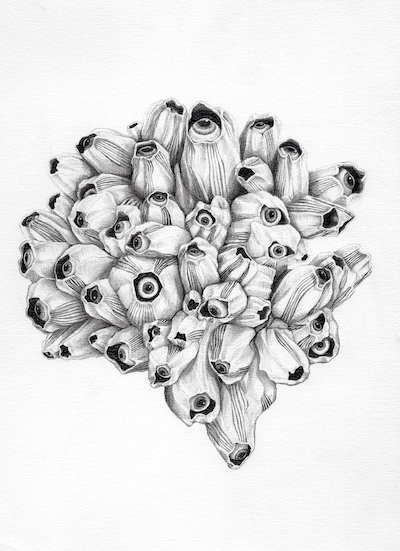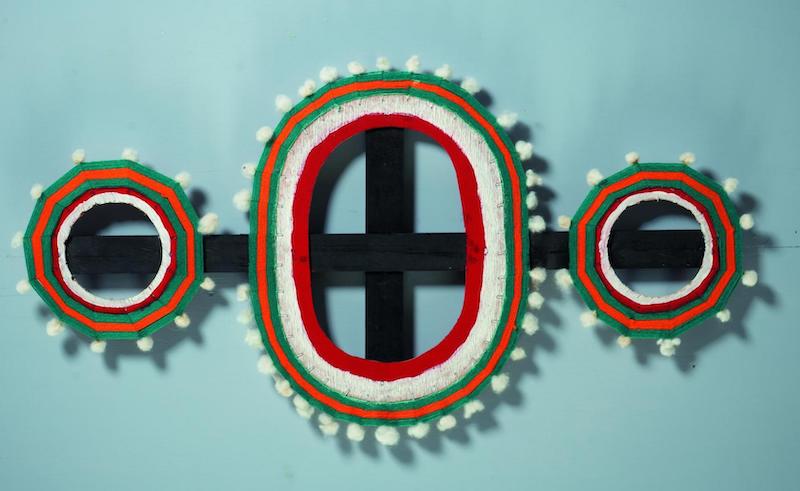Cass Lynch takes a refreshing dip in the marine-themed exhibition, ‘Reflection / Submersion’, showing at the Holmes à Court Gallery as part of Perth Festival.
Perspectives from the waves
24 February 2021
- Reading time • 6 minutesPerth Festival
More like this
- This Angel soars, even on one wing
- Power of language written on the walls
- Oh! What an extraordinary experience
‘Reflection / Submersion’, various artists curated by Laetitia Wilson ·
Holmes à Court Gallery, 19 February, 2021 ·
It’s all eyes and undertow at “Reflection / Submersion”, an exhibition at the Holmes à Court Gallery, that shows the ocean as both a mysterious depth and a light-reflecting surface.

Curated by Laetitia Wilson, the Perth Festival show features works in a range of media, from painting to video and sculpture, by Erin Coates, Carmela Corvaia, Lesley Duxbury, Jeremy Kirwan-Ward, Cecile Williams, Hiroshi Kobayashi, Sue Lovegrove, Clyde McGill, Roy Wiggan and Julie Davis.
The works take you knee deep into the salty shallows for art perspectives from the waves. As you enter the gallery, Carmela Corvaia’s plant-fibre sculpture, Sanctuary (2020), is an enigmatic sight to greet the eyes. At first glance it has the appearance of a giant sea snail shell, waist-high and roughly conical, spiralling fibres converging to a point. But walking around it one notices the curled tail at the pointed end and the sculpture takes on a more sentient feel, with what first looked like shell patterns now suggesting eyes, with jute-lined pupils glancing about.
Lidless eyeballs stare out from imagined marine shell cases in Erin Coates’ graphite drawing, Ocular Barnacles (2020), overtly observing us visitors from above the shoreline.
Oceanscapes are made graphic in the works of Hiroshi Kobayashi. The paintings are grids of single-colour dots that are machine printed and give the impression of low-resolution photographs.
The three-panel piece, The Moon Sees (2019), has a pleasant optical illusion at play within it: close-up, the eye searches for the titular moon, but the sky looks like a uniform matrix of blue dots. At the centre of the painting, however, the eye notices a group of dots that aren’t as thick as the surrounding ones – the brain knows it must be the moon, but the eye can’t quantify it. It’s only when viewed from a few metres away that the moon appears, bright and shining, at the centre of the middle panel. What vision records, what the brain suggests, and then what distance reveals … the paintings draw attention to perception and, perhaps, memory.

Eleven Ilma (1992), by Bardi artist Roy Wiggan (RIP), are visually stunning artworks that convey family memory within a cultural tradition. The term ilma refers both to Bardi ceremonies and hand-held objects that are used to teach stories, songs and law. Nine of the eleven objects are accompanied by the stories they represent. Wiggan’s ilma tell the story of his father, who was swept out to sea but lived to tell the tale. The artworks’ titles read like lines in a performance of the story: He hears the sound of the land, and He throws the spear at the dugong. The titles are followed by descriptions of what the ilma abstractly represents, which reads as pleasant poetry, perhaps even haiku:
[title] He hears the sound of the land
[description] Whirlpools (small) made by the surf.
Flat seas caused by calm winds.
We are well and truly dragged out by the tide with Julia Davis’s projected video artwork, Undercurrent (2017). The 11-minute piece starts as a monochromatic aerial shot of waves washing across a beach, each spreading a damp high watermark. Then more and more waves appear, footage overlapping, and the soundtrack deepening. The grey ocean inverts into black and the bass soundtrack distorts and rumbles, drowning the viewer visually and sonically. Davis says, “The sub-oceanic sounds in this video convey a low-frequency hydrophonic recording of Iceberg A53a breaking in the Antarctic Peninsula.” The forms that loom within the waves are perhaps manifestations of the weighty soundtrack. It’s a stunningly beautiful video, with the inverted waves reversing at the end, giving the impression of mountains capped with avalanching snow.
I’ve mentioned only half of the works in the exhibition. As a collective, they tend towards the enigmatic and require contemplation. I recommend a walk-through with a beachcomber’s attitude: an unhurried visitor glancing around for curiosities in the sand.
Reflection / Submersion is showing at the Holmes à Court Gallery until Saturday, 13 March, 2021.
Pictured top: Hiroshi Kobayashi, ‘The Moon Sees’, from ‘Reflection / Submersion’, at the Holmes à Court Gallery. Photo courtesy the artist.
Like what you're reading? Support Seesaw.





